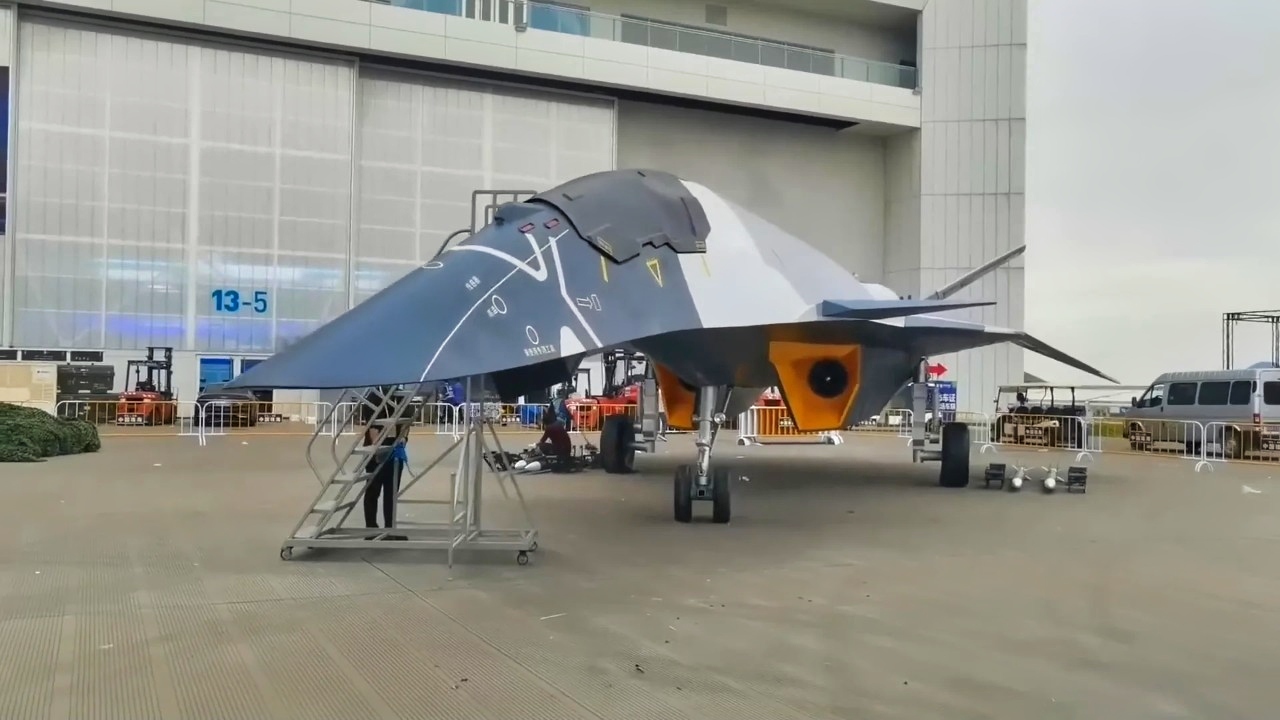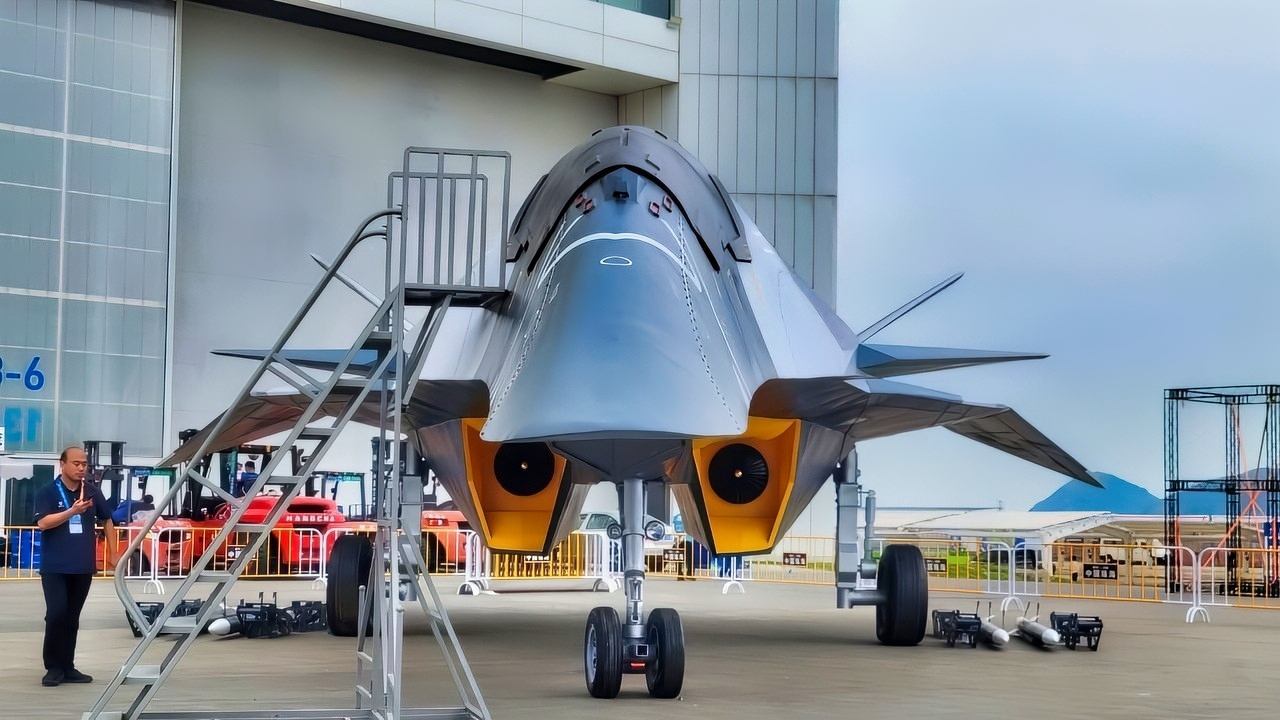Key Points and Summary – China’s “White Emperor,” a supposed sixth-generation “space-air” fighter mockup unveiled in 2024, has sparked fierce debate over its purpose.
-One theory holds it’s an early testbed for new technologies like AI sensor fusion.

White Emperor Fighter from China. Image Credit: Creative Commons.
-A more critical view suggests it’s purely symbolic propaganda, designed to signal parity with the U.S. and impose an analytical burden on Western intelligence.
-Given the massive, unproven technological leaps required, the White Emperor likely represents a long-term, speculative vision of China’s future airpower, rather than an active, near-term program. It serves primarily as a tool for analysis.
-Maybe we can sum this up in one word: fakeout?
China’s White Emperor Fighter: Visionary Leap or Showpiece?
In late 2024, at the Zhuhai Air Show, state media and the Aviation Industry Corporation of China (AVID) revealed a full-scale mock-up dubbed “White Emperor” – purportedly a sixth-generation “space-air” fighter capable of operating in near-space altitudes.
The unveiling sparked fierce debate among analysts, leaving questions about whether the project represents a serious next-generation development or merely a staged announcement intended to warn adversaries about China’s ongoing efforts to field next-generation aircraft with astounding new capabilities.
What Was (and Wasn’t) Revealed
A sleek, tailless airframe with hidden weapons bays, a blank fuselage surface, and a placard that appeared to hint at AI/data fusion technologies onboard the new craft were all seen at the airshow, alongside a placard that seemed to hint at AI/data fusion technologies onboard the new craft. From what was shown, it’s clear that the aircraft is designed for use in manned-unmanned teaming.
When it was revealed, however, observers quickly noted that the model was unflown, lacked any confirmed propulsion system or aerodynamic testing, and looked more like a device China hopes to build rather than something it is actively working on.

White Emperor 6th Generation Fighter China. Image Credit: Creative Commons.
AVIC also floated the concept of integrating space and air operations, suggesting that White Emperor could fly in the upper atmosphere, or “near space.” However, no public documentation or imagery that supports this capability. At present, it appears to be an intention more than anything.
While the mock-up was openly displayed, there appears to be no confirmed program name or even a budget line associated with the prototype. Although Chinese engineers may be working on some plans, it’s difficult to say at this stage whether the project has advanced beyond the mock-up stage.
Competing Interpretations of China’s Plans
There are competing theories about what the mock-up design really depicted and what China’s intentions are. Some say that it could, in fact, be an early full-scale testbed or demonstrator of a longer-term sixth-generation path.
The air frame, for example, might show layout experimentation in weapons bay arrangements, integration of AI with sensor fusion technology, and a conceptual control surface design.
Some also point to China’s broader aerospace momentum, with the development of several fifth- and sixth-generation aircraft intended for deployment in substantial numbers. That momentum, including rumored flight activity on the speculative Chengdu J-36, is evidence that the People’s Liberation Army (PLA) is pushing forward with new airframe designs.

J-36 Fighter from X Screenshot. Image Credit: X Screenshot.

J-36 Fighter from China. Image Credit: Creative Commons.
From this perspective, the publicly revealed mock-up is somewhat of a window into China’s future direction in the aerospace sector, but not a complete representation of what a next-generation aircraft will look like. Instead, it provides Beijing with flexibility to shape expectations and test the narrative before moving forward with a complete design.
Others, however, have speculated that the White Emperor is merely symbolic. Critics argue that it was revealed as part of an effort to signal technological parity with the United States, specifically its Next Generation Air Dominance (NGAD) program, and to impose an analytical burden on the United States and its allied intelligence communities.
In other words, critics argue that China is deliberately teasing something it cannot build to spook the United States and NATO. Those who are inclined to believe that line of thinking might also suggest that the prototype was unveiled to generate domestic and international prestige.
The mock-up has been widely described by analysts and reporters as fundamentally flawed and unrealistic, with some suggesting it resembles a Hollywood design more than a realistic one.
Where Would It Fit?
To properly assess the plausibility of the White Emperor, it’s essential to consider where it might fit against China’s known fighter efforts.
Currently, the PLA fields the J-20 Mighty Dragon, a fifth-generation stealth design, and is progressing with the J-35 naval/dual-role variant, which is under active development. China is also reported to be working on the Chengdu J-36, a trijet tailless aircraft with a diamond-double-delta wing design, which reportedly exists in the form of two working prototypes.
If the White Emperor is indeed more than just a fantasy design, it could represent a conceptual bridge – a future “J-XX” class demonstrator that can provide valuable information and lessons for real and ongoing programs. In that scenario, the mock-up shows what China intends to develop and field one day.
By examining the lessons a demonstrator like this could offer existing programs, it could also offer valuable insights into the kinds of technology Chinese engineers are actively working on today.

JH-XX Bomber Image from X Screenshot. Image Credit: X.
However, major engineering hurdles remain, including propulsion systems that can sustain high Mach speeds and operate at high altitudes.
Thermal protection for near-space operations must also be perfected, while new sensors that can withstand extreme conditions must also be developed. Add to that the necessary upgraded avionics and stealth materials that would be required, and building the White Emperor would be a monumental effort that would be hard to hide. After all, the lessons learned on a program like this would inevitably leak out into other, more immediate programs.
Rather than bridging fifth- and sixth-generation platforms, the White Emperor projects well beyond them, offering a speculative vision of what China intends its future airpower to look like once its sixth-generation aircraft arrive.
Until then, however, it serves primarily as a tool for analysts to determine China’s plans.
About the Author:
Jack Buckby is a British author, counter-extremism researcher, and journalist based in New York. Reporting on the U.K., Europe, and the U.S., he works to analyze and understand left-wing and right-wing radicalization, and reports on Western governments’ approaches to the pressing issues of today. His books and research papers explore these themes and propose pragmatic solutions to our increasingly polarized society. His latest book is The Truth Teller: RFK Jr. and the Case for a Post-Partisan Presidency.
More Military
$5,500,000,000 U.S. Navy Aircraft Carrier ‘Sunk’ by $80,000,000 Diesel Sub
A Shipyard Worker Started a Fire on a U.S. Navy Nuclear Submarine to ‘Go Home Early’
The F-35 Has a Range Problem That Can’t Be Fixed










